Featureless Build Information
On January 1, 2017, the definition of an “assault weapon” (“AW”) under California law was changed to include firearms which were required to be equipped with a “bullet button” or similar magazine locking device. Prominent 2A law firm Michel & Associates prepared a newer "Assault Weapons" Quick Reference Guide with flow chart for the California Rifle & Pistol Association and the NRA. This guide addresses the new classification of "Bullet Button Assault Weapons", and more importantly, details five options on how to stay out of trouble if you own a newly defined "assault weapon". One of those options they address is "Featureless Build", which we prefer with our CRG-15 Compliant Rifle Grip. This download is here with permission from Michel & Associates, P.C.
You can download the PDF Quick Reference Guide by clicking the image below.
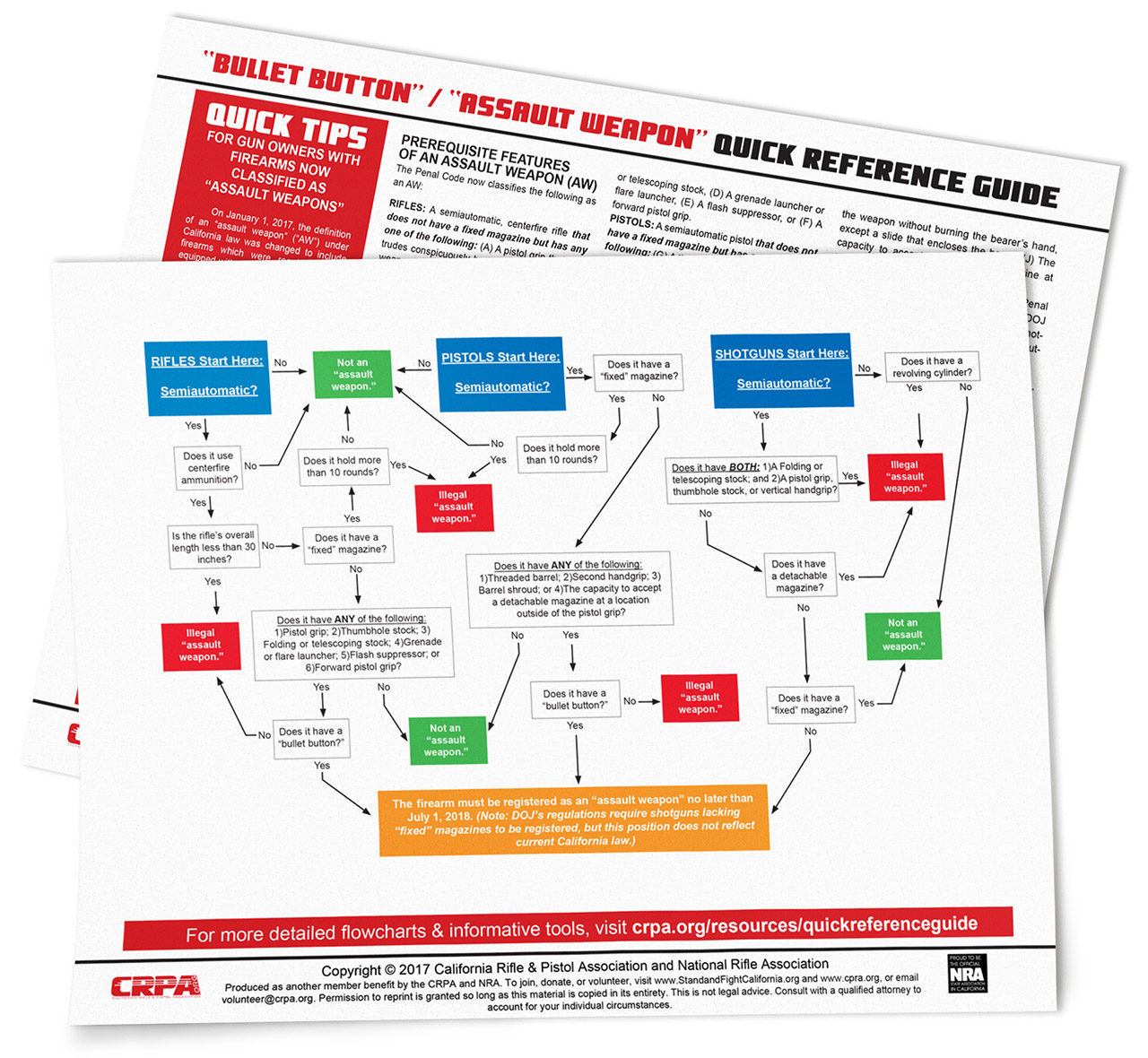
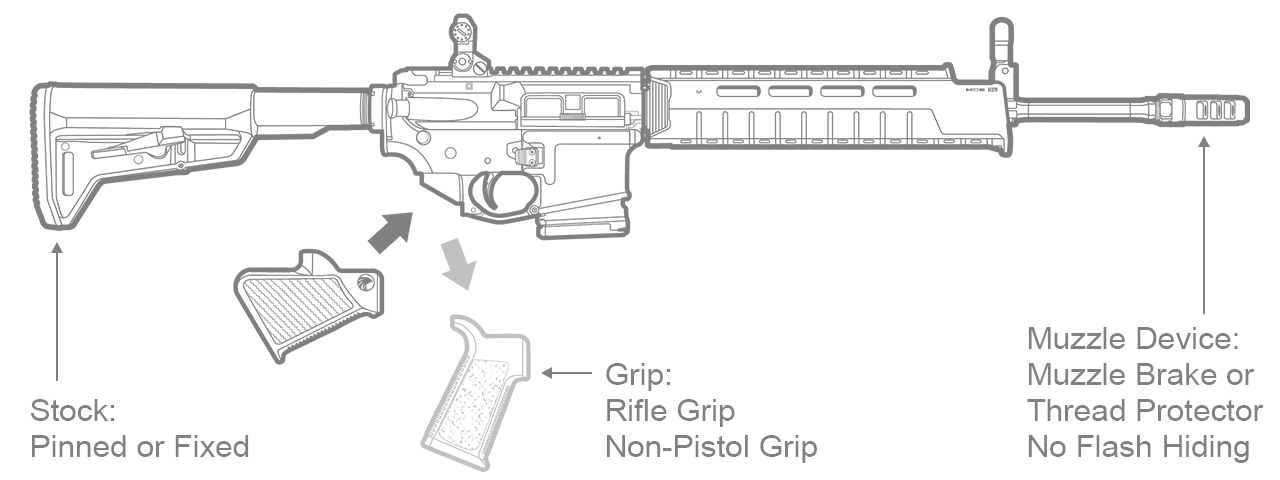
Due to the recent ruling (March 29th, 2019) in Duncan v Becerra concerning magazine capacity, we have added these next two graphics to clarify some questions that we've been receiving.
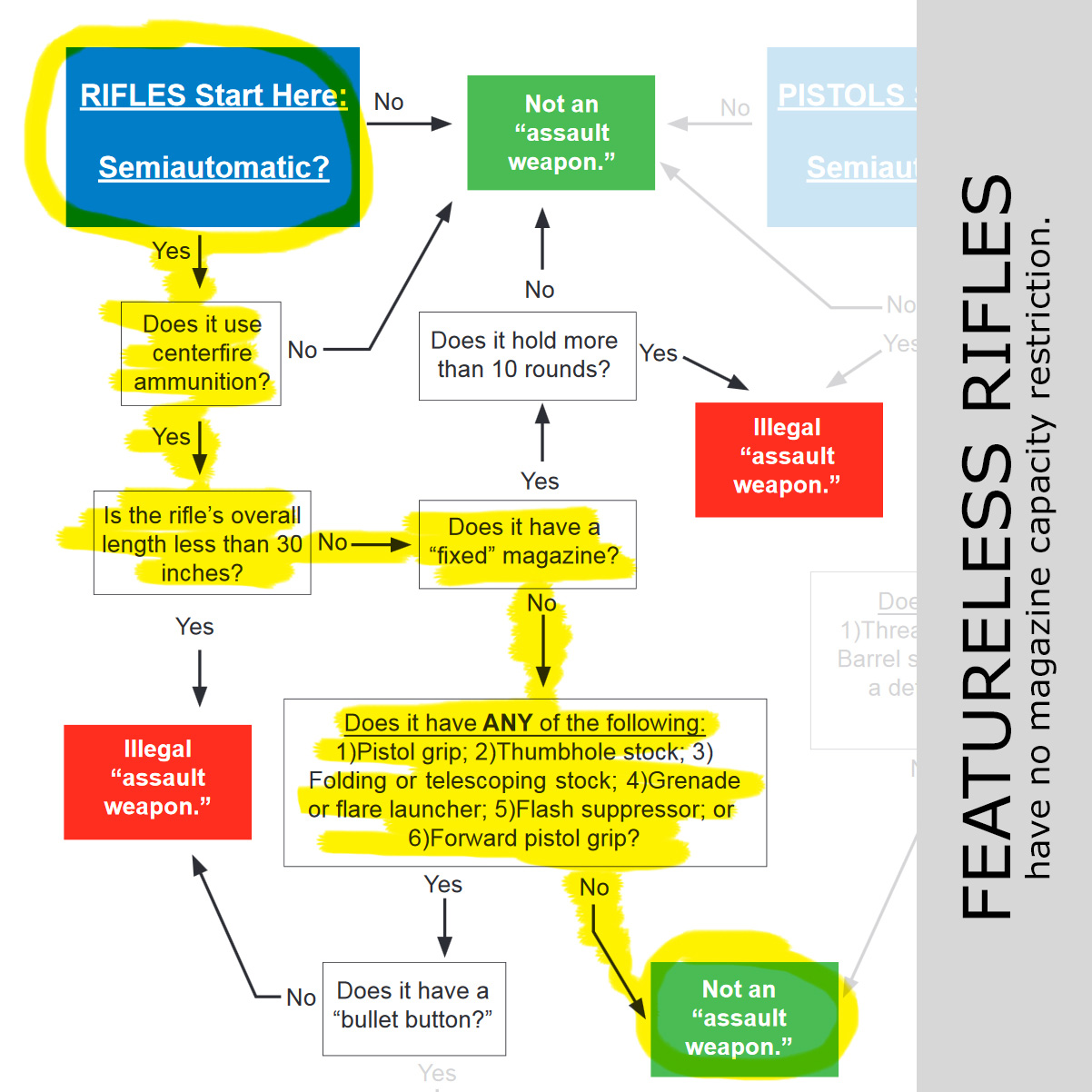
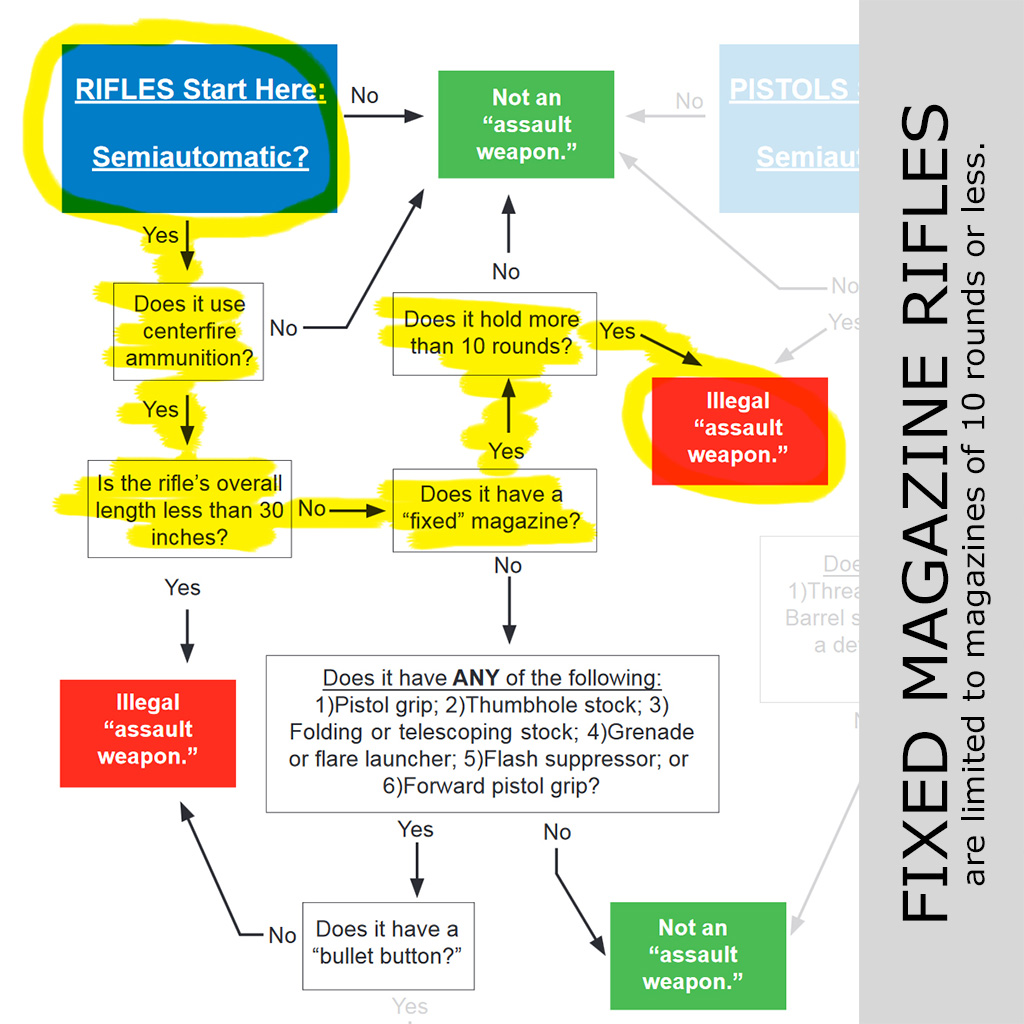
CRPA ALERT: Moving Forward with “Large Capacity” Magazine Court Ordered Stay
Click the image below for an unedited PDF version for download and easy printing (in case you would like to keep this with you and your firearms/magazines).
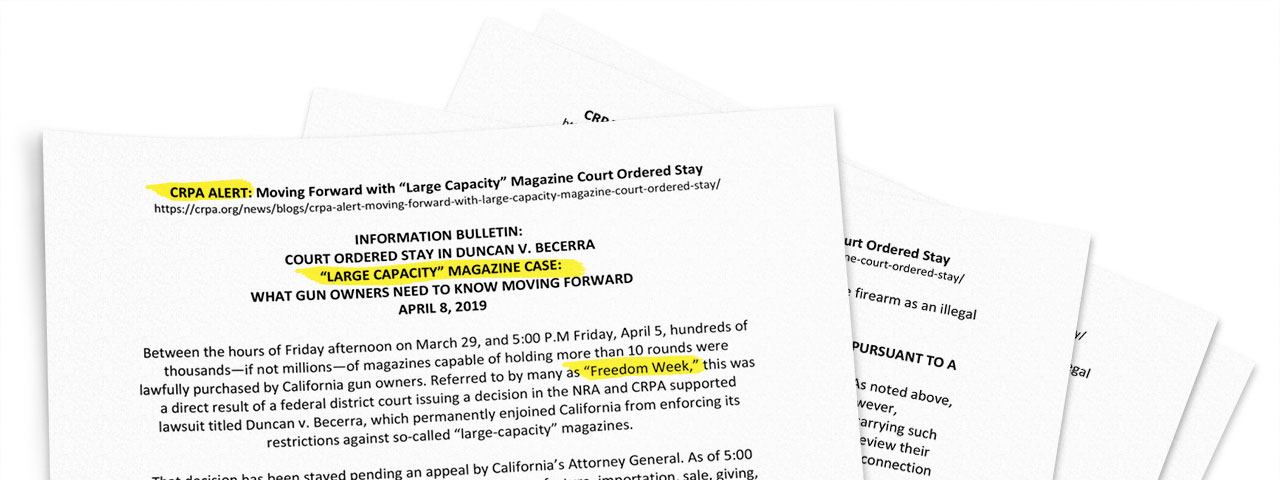
Here is the link to the original Information Bulletin from the California Rifle and Pistol Association about the current situation concerning legalities of standard capacity magazines.
CRPA Magazine Capacity Bulletin
Letter from DOJ to all CA law enforcement that it is legal to possess these magazines
Print out this PDF and toss in your range bag.
Letter from DOJ to all CA law enforcement
“Large Capacity” Magazine Update
Gun owners in CA recently had a win back in August of 2020 when the 9th Circuit 3 judge panel agreed with Judge Benitez's ruling on magazine capacity limits being unconstitutional. BUT, on March 10th 2021, the 9th Circuit vacated that ruling from the 3 judge panel and decided to hear the Duncan v. Becerra case en banc.
Definition: en banc
(on bonk) French for "in the bench," it signifies a decision by the full court of all the appeals judges in jurisdictions where there is more than one three- or four-judge panel. For the 9th Circuit, it means a full 12 judge panel.
The case is now referred to as Duncan v. Bonta (Rob Bonta was chosen to become the new attorney general after Becerra moved to secretary of health and human services under the Biden administration). Arguments were heard before the en banc panel June 22, 2021. The en banc court finally filed their ruling November 30, 2021 and it did not go in our favor (which is what we expected).
The 9th Circuit could have mandated Judge Benitez to issue a ruling in favor of the state. If that would have happened, it would be illegal to possess and use "large capacity" magazines (even the ones legally purchased during "freedom week"). But, on 12-14-21 The Duncan side requested that the 9th partially stay their mandate, and also said they planned to ask that the Supreme Court hear the case. The good news is that the state did not oppose this request, and the better news is that on 12/20/21 the 9th granted this partial stay of mandate for 150 days when they sent it back to Judge Benitez, thus allowing continued possession and use of legally acquired magazines for now.
After the big win in the win NYSRPA v. Bruen on June 23, 2022, the Supreme Court has sent (vacated and remanded) the Duncan case back down to the 9th Circuit on June 30th, 2022. BUT, the 9th will have to re-hear the case and rule based on Text, History, and Tradition adopted in Bruen instead of Intermediate Scrutiny that they have used too often to justify the restriction of gun rights. There is too much to unpack here, but we are confident in positive future results from this.
On 9/23/22 the Ninth Circuit vacated and remanded the lawsuit, which means it will now go back to the district court to be heard again. It may take some months, but we already know how Judge Benitez will rule. This left possession of "freedom week" mags in limbo. BUT, on 9/26/22 Judge Benitez issued an order continuing the stay of enforcement. (Stay of enforcement means police can't enforce this part of the law prohibiting the possession of these magazines.)
One year later on 9/22/23, Judge Benitez ruled that magazine capacity limits are unconstitutional like we expected. He also told law enforcement that they can not enforce PC 32310, but he also put a 10 day stay on this order at the request of the state to Bonta time to appeal. The state did appeal right away.
9/29/23 The 9th decided to take the case en banc (full 12 judge panel), so the 10 day stay now got extended October 10th... so no "freedom week" yet.
10/10/23 The 9th en banc panel stayed Judge Benitez's injunction... so no "freedom week" yet. They will hear the case some time in the future (basic delay tactics). One of the 9th Circuit Judges (Bumatay) in his dissent wrote "The Constitution and Californians deserve better" and "This court has repeatedly acquiesced to the violation of Californians’ right to
bear arms. Now it does so again, without even analyzing the merits of this case. Enough should be enough."
------------
On page 70 of his order on 9/22/23, Judge Benitez wrote... "The adoption of the Second Amendment was a freedom calculus decided long ago by our first citizens who cherished individual freedom with its risks more than the subservient security of a British ruler or the smothering safety of domestic lawmakers. The freedom they fought for was worth fighting for then, and that freedom is entitled to be preserved still."
This long battle is like a marathon and we should never give up when things get difficult.
In the mean time, it is still legal to posses and use legally obtained normal capacity magazines (in featureless rifles and handguns*). Local municipalities in CA may have stricter ordinances to check with first.
*handguns, not AR/AK pistols etc. which would be considered an "AW" because of other features like the magazine being located outside the grip, threaded barrels, etc.
Here is the link to the court updates on this case...
CourtListener Duncan v. Becerra
- We are currently working on some helpful information concerning building featureless rifles and hope to have that here soon.
In the mean time, here are some web links that may be helpful.
“The laws that forbid the carrying of arms are laws of such a nature. They disarm only those who are neither inclined nor determined to commit crimes…. Such laws make things worse for the assaulted and better for the assailants; they serve rather to encourage than to prevent homicides, for an unarmed man may be attacked with greater confidence than an armed man.”
– Thomas Jefferson
California Code of Regulations Title 11, Division 5 Chapter 39 Assault Weapons and Large-Capacity Magazines Article 2. § 5471 https://oag.ca.gov/sites/all/files/agweb/pdfs/firearms/regs/text-adopted-regulations-bullet-button.pdf (a) "Ability to accept a detachable magazine" means with respect to a semiautomatic shotgun, it does not have a fixed magazine. (b) "Action" means the working mechanism of a semiautomatic firearm, which is the combination of the receiver or frame and breech bolt together with the other parts of the mechanism by which a firearm is loaded, fired, and unloaded. (c) "Barrel" means the tube, usually metal and cylindrical, through which a projectile or shot charge is fired. Barrels may have a rifled or smooth bore. (d) "Barrel length" means the length of the barrel measured as follows: Without consideration of any extensions or protrusions rearward of the closed bolt or breech-face the approved procedure for measuring barrel length is to measure from the closed bolt (or breech-face) to the furthermost end of the barrel or permanently attached muzzle device. Permanent methods of attachment include full-fusion gas or electric steel-seam welding, high-temperature (1100o F) silver soldering, or blind pinning with the pin head welded over. Barrels are measured by inserting a dowel rod into the barrel until the rod stops against the closed bolt or breech-face. The rod is then marked at the furthermost end of the barrel or permanently attached muzzle device, withdrawn from the barrel, and measured. (e) "Bullet" means the projectile expelled from a gun. It is not synonymous with a cartridge. Bullets can be of many materials, shapes, weights, and constructions such as solid lead, lead with a jacket of harder metal, round-nosed, flat-nosed, hollow-pointed, et cetera. (f) "Bullet-button" means a product requiring a tool to remove an ammunition feeding device or magazine by depressing a recessed button or lever shielded by a magazine lock. A bullet-button equipped fully functional semiautomatic firearm does not meet the fixed magazine definition under Penal Code section 30515(b). (g) "Bore" means the interior of a firearm's barrel excluding the chamber. (h) "Caliber" means the nominal diameter of a projectile of a rifled firearm or the diameter between lands in a rifled barrel. In the United States, caliber is usually expressed in hundreds of an inch; in Great Britain in thousandths of an inch; in Europe and elsewhere in millimeters. (i) "Cartridge" means a complete round of ammunition that consists of a primer, a case, propellant powder and one or more projectiles. (j) "Centerfire" means a cartridge with its primer located in the center of the base of the case. (k) "Contained in" means that the magazine cannot be released from the firearm while the action is assembled. For AR-15 style firearms this means the magazine cannot be released from the firearm while the upper receiver and lower receiver are joined together. (l) "Department" means the California Department of Justice. (m) "Detachable magazine" means any ammunition feeding device that can be removed readily from the firearm without disassembly of the firearm action or use of a tool. A bullet or ammunition cartridge is considered a tool. An ammunition feeding device includes any belted or linked ammunition, but does not include clips, en bloc clips, or stripper clips that load cartridges into the magazine. An AR-15 style firearm that has a bullet-button style magazine release with a magnet left on the bullet-button constitutes a detachable magazine. An AR-15 style firearm lacking a magazine catch assembly (magazine catch, magazine catch spring and magazine release button) constitutes a detachable magazine. An AK-47 style firearm lacking a magazine catch assembly (magazine catch, spring and rivet/pin) constitutes a detachable magazine. (n) "Disassembly of the firearm action" means the fire control assembly is detached from the action in such a way that the action has been interrupted and will not function. For example, disassembling the action on a two part receiver, like that on an AR-15 style firearm, would require the rear take down pin to be removed, the upper receiver lifted upwards and away from the lower receiver using the front pivot pin as the fulcrum, before the magazine may be removed. (o) "Featureless" means a semiautomatic firearm (rifle, pistol, or shotgun) lacking the characteristics associated with that weapon, as listed in Penal Code section 30515. (p) "Fixed magazine" means an ammunition feeding device contained in, or permanently attached to, a firearm in such a manner that the device cannot be removed without disassembly of the firearm action. (q) "Flare launcher" means a device used to launch signal flares. (r) "Flash suppressor" means any device attached to the end of the barrel, that is designed, intended, or functions to perceptibly reduce or redirect muzzle flash from the shooter's field of vision. A hybrid device that has either advertised flash suppressing properties or functionally has flash suppressing properties would be deemed a flash suppressor. A device labeled or identified by its manufacturer as a flash hider would be deemed a flash suppressor. (s) "FMBUS" means a Firearm Manufactured By Unlicensed Subject. (t) "Forward pistol grip" means a grip that allows for a pistol style grasp forward of the trigger. (u) "Frame" means the receiver of a pistol. (v) "Grenade launcher" means a device capable of launching a grenade. (w) "Permanently attached to" means the magazine is welded, epoxied, or riveted into the magazine well. A firearm with a magazine housed in a sealed magazine well and then welded, epoxied, or riveted into the sealed magazine well meets the definition of "permanently attached to". (x) "Overall length of less than 30 inches" with respect to a centerfire rifle means the rifle has been measured in the shortest possible configuration that the weapon will function/fire and the measurement is less than 30 inches. Folding and telescoping stocks shall be collapsed prior to measurement. The approved method for measuring the length of the rifle is to measure the firearm from the end of the barrel, or permanently attached muzzle device, if so equipped, to that part of the stock that is furthest from the end of the barrel, or permanently attached muzzle device. (Prior to taking a measurement the owner must also check any muzzle devices for how they are attached to the barrel.) (y) "Pistol" means any device designed to be used as a weapon, from which a projectile is expelled by the force of any explosion, or other form of combustion, and that has a barrel less than 16 inches in length. This definition includes AR-15 style pistols with pistol buffer tubes attached. Pistol buffer tubes typically have smooth metal with no guide on the bottom for rifle stocks to be attached, and they sometimes have a foam pad on the end of the tube farthest from the receiver. (z) "Pistol grip that protrudes conspicuously beneath the action of the weapon" means a grip that allows for a pistol style grasp in which the web of the trigger hand (between the thumb and index finger) can be placed beneath or below the top of the exposed portion of the trigger while firing. This definition includes pistol grips on bullpup firearm designs. (aa) "Receiver" means the basic unit of a firearm which houses the firing and breech mechanisms and to which the barrel and stock are assembled. (bb) "Receiver, lower" means the lower part of a two part receiver. (cc) "Receiver, unfinished" means a precursor part to a firearm that is not yet legally a firearm. Unfinished receivers may be found in various levels of completion. As more finishing work is completed the precursor part gradually becomes a firearm. Some just have the shape of an AR-15 lower receiver for example, but are solid metal. Some have been worked on and the magazine well has been machined open. Firearms Manufactured by Unlicensed Subjects (FMBUS) began as unfinished receivers. (dd) "Receiver, upper" means the top portion of a two part receiver. (ee) "Rifle" means a weapon designed or redesigned, made or remade, and intended to be fired from the shoulder and designed or redesigned and made or remade to use the energy of the explosive in a fixed cartridge to fire only a single projectile through a rifled bore for each single pull of the trigger. (ff) "Rimfire" means a rimmed or flanged cartridge with the priming mixture located in the rim of the case. (gg) "Second handgrip" means a grip that allows the shooter to grip the pistol with their non-trigger hand. The second hand grip often has a grip texture to assist the shooter in weapon control. (hh) "Semiautomatic" means a firearm functionally able to fire a single cartridge, eject the empty case, and reload the chamber each time the trigger is pulled and released. Further, certain necessary mechanical parts that will allow a firearm to function in a semiautomatic nature must be present for a weapon to be deemed semiautomatic. A weapon clearly designed to be semiautomatic but lacking a firing pin, bolt carrier, gas tube, or some other crucial part of the firearm is not semiautomatic for purposes of Penal Code sections 30515, 30600, 30605(a), and 30900. (1) A mechanically whole semiautomatic firearm merely lacking ammunition and a proper magazine is a semiautomatic firearm. (2) A mechanically whole semiautomatic firearm disabled by a gun lock or other firearm safety device is a semiautomatic firearm. (All necessary parts are present, once the gun lock or firearm safety device is removed, and weapon can be loaded with a magazine and proper ammunition.) (3) With regards to an AR-15 style firearm, if a complete upper receiver and a complete lower receiver are completely detached from one another, but still in the possession or under the custody or control of the same person, the firearm is not a semiautomatic firearm. (4) A stripped AR-15 lower receiver, when sold at a California gun store, is not a semiautomatic firearm. (The action type, among other things, is undetermined.) (ii) "Shotgun with a revolving cylinder" means a shotgun that holds its ammunition in a cylinder that acts as a chamber much like a revolver. To meet this definition the shotgun's cylinder must mechanically revolve or rotate each time the weapon is fired. A cylinder that must be manually rotated by the shooter does not qualify as a revolving cylinder. (jj) "Shroud" means a heat shield that is attached to, or partially or completely encircles the barrel, allowing the shooter to fire the weapon with one hand and grasp the firearm over the barrel with the other hand without burning the shooter's hand. A slide that encloses the barrel is not a shroud. (kk) "Spigot" means a muzzle device on some firearms that are intended to fire grenades. The spigot is what the grenade is attached to prior to the launching of a grenade. (ll) "Stock" means the part of a rifle, carbine, or shotgun to which the receiver is attached and which provides a means for holding the weapon to the shoulder. A stock may be fixed, folding, or telescoping. (mm) "Stock, fixed" means a stock that does not move, fold, or telescope. (nn) "Stock, folding" means a stock which is hinged in some fashion to the receiver to allow the stock to be folded next to the receiver to reduce the overall length of the firearm. This definition includes under folding and over folding stocks. (oo) "Stock, telescoping" means a stock which is shortened or lengthened by allowing one section to telescope into another portion. On AR-15 style firearms, the buffer tube or receiver extension acts as the fixed part of the stock on which the telescoping butt stock slides or telescopes. (pp) "Those weapons with an ammunition feeding device that can be readily removed from the firearm with the use of a tool" includes functional semiautomatic rifles, pistols, and shotguns with bullet-button style magazine releases. These weapons do not have a fixed magazine. (qq) "Thumbhole stock" means a stock with a hole that allows the thumb of the trigger hand to penetrate into or through the stock while firing. (rr) "Threaded barrel, capable of accepting a flash suppressor, forward handgrip, or silencer" means a threaded barrel able to accept a flash suppressor, forward handgrip, or silencer, and includes a threaded barrel with any one of those features already mounted on it. Some firearms have "lugs" in lieu of threads on the end of the barrel. These lugs are used to attach some versions of silencers. For purposes of this definition a lugged barrel is the same as a threaded barrel. Cal. Code Regs. Tit. 11, § 5471
|